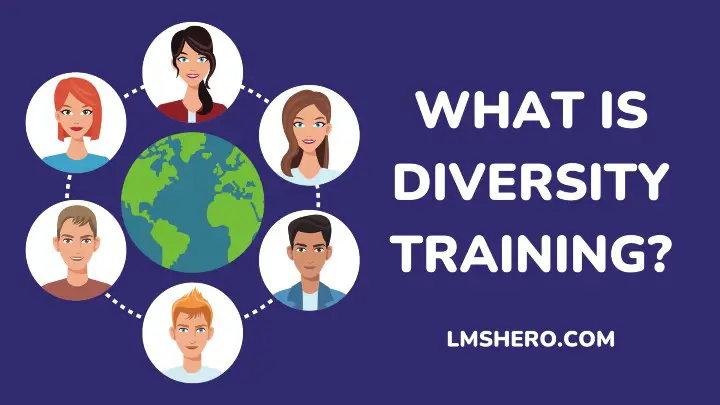Diversity training is a collection of workshops, classes, and in-person events designed to educate and develop understanding across group boundaries. This training focuses on embracing all differences aimed at bringing people together.
Also, diversity training involves learning about race, gender, sexual orientation, religion, and more. It’s about learning to understand people of all different backgrounds.
Diversity is something that people don’t experience or understand every day because they aren’t exposed to it much in their everyday lives.
It is also the formal process of educating all employees or students in an agency, firm, or institution about the basic principles of diversity.
Furthermore, it aims to eliminate racism, sexism, ageism, and other prejudices present within a community or organization.
This article highlights the intended benefits of diversity training and why it is important in organizations and society in general.
What Is Diversity?
Diversity refers to the variety of people, skills, lifestyles, cultures, languages, and interests present in a society, location, or organization.
Often shortened to inclusion, diversity focuses on valuing differences but not necessarily assimilating them.
However, another interpretation is that diversity is a characteristic of multiple forms such as race, gender, wealth, and social status. It is also about variety, about both the characteristics that make us unique as individuals and those that make us alike as a group.
Therefore, a diverse group is one in which each person brings his unique ideas and characteristics to the table to make the whole greater than any one person could be alone.
Diversity training addresses conscious and unconscious biases and the resulting discrimination found in any community where different people have access to power.
Why Is Diversity Training Important?
The primary advantage of diversity training is to create a culture that encourages positive intergroup interaction, reduces prejudice and discrimination, and enhances teamwork in the workplace.
Additionally, other benefits include anti-bias training, multicultural education, multicultural competence, multicultural staff recruitment and retention, multicultural counseling, and reductions in racism.
Furthermore, diversity programs that promote positive intergroup interaction help reduce racism, sexism, and the average tenure of diverse workers. It’s a good idea to offer anti-bias training for both employees and managers so that they can recognize their own biases.
An anti-bias program will also promote diversity among high-ranking executives or individuals who have a say in hiring new employees.
In addition, it is a necessary step in creating a more caring work environment that promotes respect and appreciation.
What Are the Benefits of Diversity Training?
A diversity program is the most effective way of achieving positive intergroup interactions.
According to experts, anti-bias training can reduce prejudices and discrimination. Diversity evaluations also help to find ways to promote equal opportunity in employment.
Reducing or eliminating prejudice and discrimination in the workplace or any organization creates an anti-bias environment that supports individual growth, motivation, and productivity.
Also, it helps in building stronger relationships, improving workplace productivity and performance, reinforcing ethical standards, and developing a culture of teamwork to drive corporate success.
Other benefits of diversity programs include:
1. It Helps to Reduce Discrimination, Harassment, and Bullying
An inclusive environment is crucial for building a welcoming community.
By proactively addressing diversity in the workplace, you create a work environment that is fair and respectful to all team members.
Individuals must learn to respect one another, appreciate cultural differences, and embrace equality among all people.
Diversity training programs must be designed effectively and implemented properly if organizations want to achieve this goal.
These workshops help increase the positivity and creativity of your organization and build a stronger, more equal workforce based on respect and acceptance.
Also, diversity evaluations provide data on evaluating progress toward reducing discrimination, harassment, and bullying.
2. Improves Communication, Morale, and Productivity
Anti-bias training improves communications, morale, and productivity by addressing perceptions of organizational inequity, changing beliefs, and reducing prejudice and discrimination.
Also, a diverse team has better communication, is more innovative and creative, and simply works better.
You can also gain the benefits of diversity in your organization by providing training to raise awareness and improve intergroup interactions.
Furthermore, teaching employees about diversity can have many positive effects.
Diversity courses may help employees better understand each other’s needs and feelings, and help them communicate better.
3. It Improves Employee Attitudes Towards People of Diverse Races and Cultures
Maintaining high workplace performance requires improved intergroup relations among diverse workforces and clients of various cultures and races.
Also, anti-bias training can improve attitudes toward people of different races and cultures. It can also reduce prejudice and discrimination and will help people learn to value other individuals despite how they perceive their race or culture.
Furthermore, this training is a time-proven method used by organizations to improve employee attitudes toward people of diverse races and cultures.
It is crucial in an era when racial tensions, discrimination, and low-level harassment are flourishing in many organizations.
4. It Reduces Costly Lawsuits
Employers are not immune to the costs of litigation, employee turnover, and lost work hours that result when employees can’t interact well with their colleagues. A well-designed training program can help reduce the likelihood of these expensive outcomes.
It also reduces costly lawsuits, supports compliance with affirmative action laws and regulations, and helps boost worker productivity by reducing prejudice and discrimination.
Anti-bias training can also help your company attract a diverse workforce, mitigate employee conflict, and enable better communication across ethnic groups.
It also creates a work environment that values all employees no matter their race, religion, or sexual orientation. Ridding yourself of biases, stereotypes, and discrimination is essential to preventing workplace-related problems.
5. Keeps Employees Happy, Mentally Healthy, and Safe
Diversity programs increase productivity, help your business attract and retain top talent, and makes your employees happier and healthier. This makes for more fulfilling work environments and improved quality of life daily.
Additionally, this training helps employees interact more effectively with people from different backgrounds, which in turn can boost employee satisfaction, and retention. It also keeps the office mentally healthy, and happiness is key to the success of your business.
6. Diversity Training Leads to Improved Company Image and Brand Awareness
A business’s idea of diversity doesn’t always align with its customers. Hence, diversity programs help businesses understand, observe and embrace diversity in the workplace.
This training consists of several phases that address a company’s weaknesses and boost its outlook on clients.
Also, when done correctly, anti-bias training can help companies improve their overall brand and company image. It also aids in creating a more diverse and accepting environment that leads to people of various origins and orientations being comfortable doing business with the company.
7. Diversity Training Increases the Innovation and Creativity of Employees
It’s possible to achieve new levels of success when employees have the opportunity to work with people from different backgrounds.
Reducing prejudice and discrimination makes it easier for employees to work together more effectively and create new innovative ways of carrying out job operations.
Also, in today’s diverse world, companies need the benefits of cultural diversity to remain competitive. This training can help your company adapt to those changes by increasing the innovation and creativity of your employees.
Additionally, it is easier to solve problems in intergroup settings when you can talk to each other with sincere intentions and goodwill.
8. It Aids Multicultural Recruitment and Diversity in the Workplace
Corporate anti-bias training is the critical first step companies should take in creating a diverse workplace, and improving leadership and management. The program also helps employees feel more valued, motivated, and enthusiastic about their work.
This training helps human resource departments and organizations create a diverse workplace by pre-screening job applicants for cultural sensitivity and allying competence.
9. Help Employees Understand the Value of a Diverse Culture
These programs address diversity fundamentals and stereotypes to create a more accepting environment in the workplace. They also discuss the different cultures and historical events whose impact remains in modern society.
Also, the program aids in developing successful managers who create equitable workplaces and results in reduced risks of discrimination, harassment, and retaliation.
What Are the Challenges Affecting Diversity Training?
The biggest challenge is getting employees to practice what they learned in their training sessions.
Another challenge for diversity training is making it relevant to everyone. That includes managers and executives where these discriminatory practices are dominant.
However, training alone will never create the positive intergroup interaction necessary to reduce prejudice and discrimination.
Only through the evaluation of diversity programs can managers determine how well diversity training is working.
Also, while diversity training has increased among organizations, a recent meta-analysis of hundreds of studies shows that diversity training is often ineffective.
The science of this training is not right sometimes, the delivery method is off, and companies are not measuring outcomes, so they have no idea if the programs they’re investing in are successful.
FAQs
What makes diversity training ineffective?
Diversity training is ineffective if trainees do not commit fully to the methods of the change strategy.
Trainers also need to be committed to training people to change their attitudes and behavior toward diversity.
Many diversity programs completely miss the mark from the beginning by underestimating how deeply embedded social stereotypes are in society.
Furthermore, this training needs to be direct and realistic about the challenges involved in creating effective positive intergroup relations.
Does diversity training fully prevent discrimination in the workplace?
No, it does not. Numerous studies confirm that training employees to improve skills, such as communication, will not necessarily prevent discrimination in the workplace.
However, when done well and combined with actual behavioral interventions, anti-bias training can increase acceptance of cultural differences and reduce intergroup conflict.
How does diversity training benefit society?
As a result of diversity training, less stereotyping will occur and it may be easier for employees to get along with each other. It would also change how these employees view diverse groups outside their work environment and reduce discriminatory acts.
Additionally, when people are taught about diversity issues, in the workplace and beyond, they are able to recognize cultural differences. They are also able to acknowledge that each person is unique.
Conclusion
Diversity training increases participants’ knowledge and communication skills while reducing workplace bias, conflict, counterproductive behavior, and negative emotional responses. Enlightening people about diversity should not be limited to the workplace.
Additionally, It is always better to imbibe this culture in kids at a young age. Children who interact with people from multicultural backgrounds or varying sexual orientations from a young age are less likely to discriminate.
Finally, by educating children on the values of a diverse society, you successfully prevent discrimination and racism from manifesting in them as adults. That is why diversity is necessary for schools. Read more on the importance of diversity in schools and its benefits.
I hope you found this article helpful. Thanks for reading.






